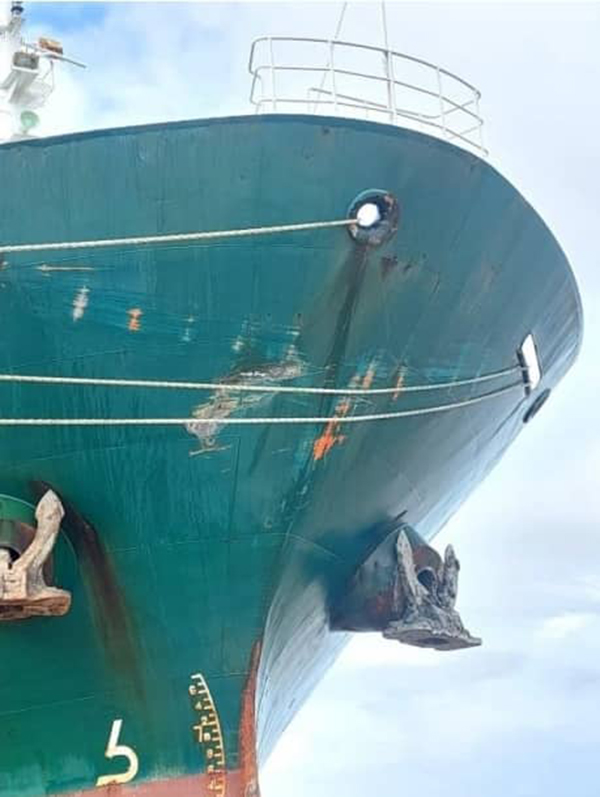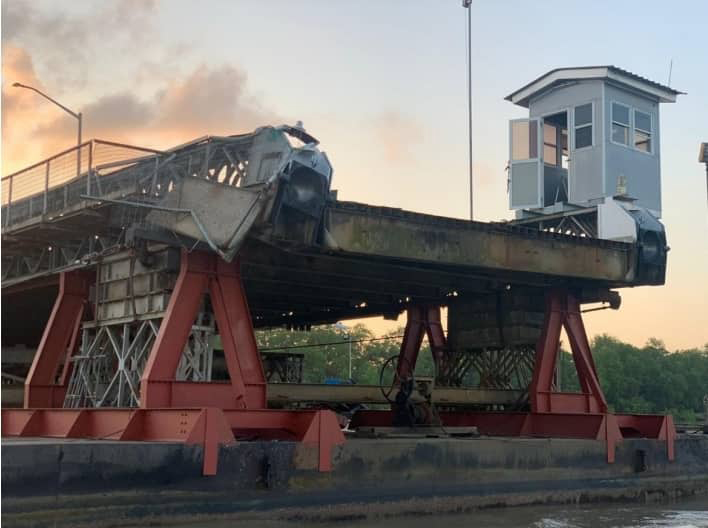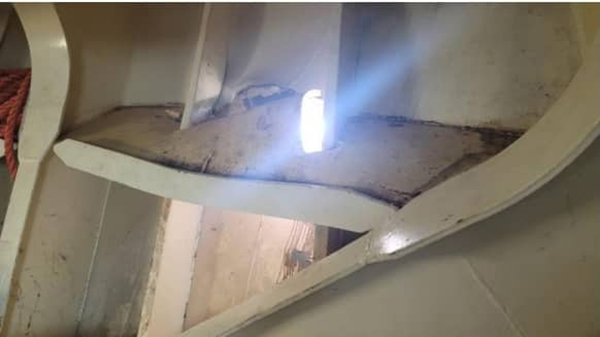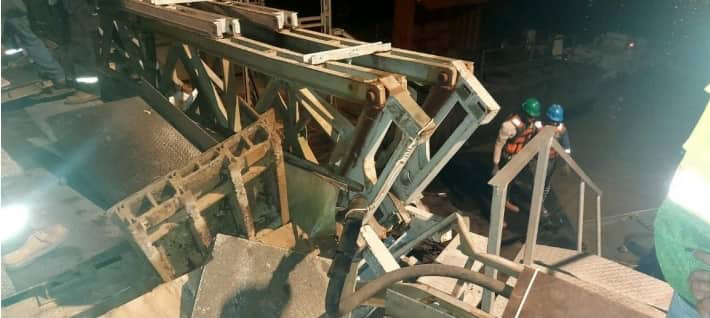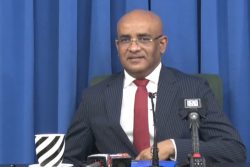Apart from implementing several policies in keeping with international standards and the requirement for annual medical tests for river pilots, the Board of Inquiry (BoI) into the major accident at the Demerara Harbour Bridge (DHB) earlier this month has recommended that the conduct of pilots and ships’ masters should be documented.
Also, Kenneth Cort, the suspended pilot of the Panamanian registered vessel, MV Tradewind Passion involved in the collision can only return to duty after a process or recertification, assessment of his competency to operate as a pilot by the Maritime Administration Department (MARAD).
These are among recommendations which were made by the Ministry of Public Work’s BoI report which was released yesterday.
“The DHB, Guyana National Shipping Corporation were not equipped with any documented reports of pilots and ship masters conduct that were not in compliance with good practices for safe transit of the DHB although there were numerous verbal reports of such and had such reports been reported to relevant authorities for action (the) pilot would not have been onboard the Tradewind Passion. Therefore, with immediate effect all shipping agencies, DHB and MARAD must set policies and guidelines for all mariners transiting the DHB and all reports of breach of such policies set must be documented, investigated and appropriate actions taken,” the team assigned to probe the accident concluded.
“Pilot Kenneth Cort who was on the Tradewind Passion must be suspended for a period of not less than 24 months and only be allowed to return to duty after a process or recertification, assessment of his competency to operate as a pilot by MARAD,” they added.
Among other things, the findings of the investigation revealed that the night shift supervisor experienced difficulty in identifying the vessel when he first observed it moving west of the transit area. “As such the DHB must work in collaboration with the Georgetown Lighthouse to identify errant vessels in a timely manner so that early warnings could be relayed,” the report revealed.
To avoid future recurrence, the team has recommended that a number of new measures/policies be implemented as it relates to the operation of the DBH.
These include 24-hour monitoring by all stations including the main radio room and the installation of infrared as well as CCTV security cameras to assist the process of identifying any approaching policy breaches regarding bridge transit. “These cameras will also aid the investigating process should there be any breaches,” the team recommended.
Further, it was advised that in light of the impending increase in marine traffic, International Collision Regulations/Convention to which Guyana is a party must be implemented as a matter of priority and major shipping companies should seek “professional” guidance on ship requirements according to international and local laws before contractual services are finalized.
It is now a requirement for all transit pilots to be subjected to annual medical fitness tests including, hearing tests and periodic psychological evaluation.
The accident occurred just about 2am on October 8 after the MV Tradewind Passion crashed into the bridge damaging four spans. At the time, the Panamanian registered vessel was navigating the channel to offload fuel at GuyOil’s Providence Terminal.
The vessel shifted the bridge about 45 degrees out of alignment while damaging spans 8,9,10 and 11. The damage has been labelled as extraordinary and requires a lot of technical work to restore the bridge to its previous state.
DHB Company Ship Supervisor, Andy Duke was also seriously injured after he was forced to jump from a tower to get to safety.
Other proposals
The team also made a series of proposals for river pilots and crew members, DHB manning staff and its retraction.
Once implemented, these new measures are likely to see some changes in the operation of the DHB, particularly as it relates to river traffic.
At the handing over of the report, Minister of Public Works Juan Edghill had said that the investigation found that all of the navigational aids and everything to facilitate passage of the vessel through the DHB were fully functional. He noted that the four other vessels that transited prior to Tradewind Passion had no complaints.
In its recommendations, the team suggested that the acquisition and operationalization of adequate and appropriate vessel monitoring systems and maritime surveillance systems should be prioritized for all maritime zones, including internal waters and “all” vessels transiting the DHB should be mandated to possess Protection and Indemnity (P&I) insurance policies.
It was also highlighted that “no” vessels with steering, mechanical and adverse stability condition deficiencies must be allowed to transit the DHB unless such deficiencies are verified by MARAD and contingencies are in place to facilitate transit.
Further, it was recommended by the team that all single screw convention size vessels transiting the DHB should be tug assisted and policy directives should specifically address bridge zones and bridge control areas by grid coordinates and to outline control mechanisms for the various zones.
The team recommended that that the southern limit of Port Georgetown should be statutorily extended to the Grove anchorage area. “Further MARAD and the competent authority should enlist MARAD pilots who are certified for Berbice Bridge transit to be the pilots for the DHB transit until such time other MARAD pilots are certified for the DHB transit,” the report said.
Additionally, it proposed that the DHB review the arrangement and size of the cluster piles to provide for the most robust protection of the retractor area of the bridge and consider adjusting the height of the pedestal of the lights so as to avoid background lights from interfering with mariners’ line of sight of all transit lights.
Regarding the operation of the bridge itself, the team recommended that the bridge retraction schedule when prepared by the DHBC should be approved by MARAD before publication. “More DHB staff on duty in the retraction area should be equipped with radio communication devices and night shift supervisor provided with night vision binoculars,” they said.
“Night work in way of welding must not be done during ship transit, light house attendants (should) be provided with night vision binoculars for better coverage of the port area and light house attendants should monitor channel 12 which is used by the DHB for vessels transiting the retractor span to provide any assistance that may be necessary such as to relay messages to vessels that cannot be reached by DHB communication centre and Shift supervisor,” the team noted.
With immediate effect, as previously reported, it was also recommended that the River Pilotage Service fall under the administration of MARAD.
Estimated damage
The bridge was only reopened to vehicular traffic on the evening of October 10th but weight limitations were put in place as repair works were still ongoing.
The report disclosed that the final cost of the damage as a result of the accident is estimated at about US$5 million which is equivalent to $1B, and counting.
The repair works on the 42-year-old bridge involve the replacement of two pontoons that were damaged as a result of the impact. Additionally, a number of supporting structures had to be completely replaced.
The repair works were undertaken by both the government and private sector bodies.
The report pointed out some of the damage caused to the bridge as well as the vessel which were both visited as part of the inquiry.
This includes two sets of 15-pile clusters on the north western side of the bridge being mowed down, damage to a pontoon, damage to the special connecting posts at spans 7/8 and 11/12, severe damage to the transom beams at spans 7/8 and 11/12 as well as the transom beam under the ramp and damage to about 15 anchor blocks.
Both the eastern and western sections of the bridge were also forced out of original and alignment at approximately 45 degrees southwest, and northeast, respectively, the report said.
As it relates to the Tradewind Passion vessel, it was noted that there was damage to the starboard bow resulting from the impact with the bridge and the interior frame of the starboard bow.
Hours after the accident, Minister Edghill announced that a BoI had been established. The members were Captain Joseph Lewis who is a marine officer and surveyor of ships, MARAD Legal Director Thandi McAllister, Youlanda Hughes, Inspector Ross from the Marine Wing of the GPF, Lieutenant Colonel David Shamshudeen from the Coast Guard, Chief Transport and Planning Officer Patrick Thompson and a Board Member of the Guyana National Shipping Corporation, Dimitri Ali.
The Board was given seven days to complete its work.
